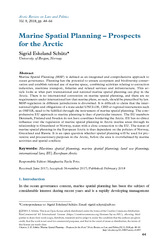| dc.contributor.author | Schütz, Sigrid Eskeland | |
| dc.date.accessioned | 2019-09-17T12:16:14Z | |
| dc.date.available | 2019-09-17T12:16:14Z | |
| dc.date.issued | 2018-02-09 | |
| dc.Published | Schütz SE. Marine Spatial Planning – Prospects for the Arctic. Arctic Review on Law and Politics. 2018;9:44-66 | eng |
| dc.identifier.issn | 1891-6252 | |
| dc.identifier.issn | 2387-4562 | |
| dc.identifier.uri | https://hdl.handle.net/1956/20840 | |
| dc.description.abstract | Marine Spatial Planning (MSP) is defined as an integrated and comprehensive approach to ocean governance. Planning has the potential to ensure ecosystem and biodiversity conservation and establish rational use of marine space, combining activities relating to extraction industries, maritime transport, fisheries and related services and infrastructure. This article looks at what part transnational and national marine spatial planning can play in the Arctic. There is no international convention on marine spatial planning, and there are no requirements under international law that marine plans, as such, should be prescribed by law. MSP-regulation in different jurisdictions is diversified. It is difficult to claim that the international rights and obligations of a state under UNCLOS, CBD or regional instruments such as OSPAR, need to be fulfilled through the instrument of marine spatial planning. The comprehensive EU approach to marine planning is thus of particular interest. The EU members Denmark, Finland and Sweden do not have coastlines bordering the Arctic. EU has no direct influence over the regulation of marine spatial planning in Arctic marine areas through its relationship to Greenland or Norway, states with a close connection to the EU. The status of marine spatial planning in the European Arctic is thus dependent on the policies of Norway, Greenland and Russia. It is an open question whether spatial planning will be used for preventive and precautionary purposes in the Arctic, before the area is overwhelmed by marine activities and spatial conflicts. | en_US |
| dc.language.iso | eng | eng |
| dc.publisher | Cappelen Damm Akademisk | eng |
| dc.relation.uri | https://arcticreview.no/index.php/arctic/article/view/899 | |
| dc.rights | Attribution-NonCommercial CC BY-NC | eng |
| dc.rights.uri | http://creativecommons.org/licenses/by-nc/4.0/ | eng |
| dc.subject | Maritime spatial planning | eng |
| dc.subject | Marine spatial planning | eng |
| dc.subject | Land use planning | eng |
| dc.subject | International law | eng |
| dc.subject | EU | eng |
| dc.subject | European Arctic | eng |
| dc.title | Marine Spatial Planning – Prospects for the Arctic | eng |
| dc.type | Journal article | |
| dc.type | Peer reviewed | |
| dc.date.updated | 2019-07-22T12:00:05Z | |
| dc.description.version | publishedVersion | |
| dc.rights.holder | Copyright 2018 S. E. Schütz. | eng |
| dc.identifier.doi | https://doi.org/10.23865/arctic.v9.899 | |
| dc.identifier.cristin | 1571232 | |
| dc.source.journal | Arctic Review on Law and Politics | |
| dc.relation.project | Norges forskningsråd: 255586 | |

